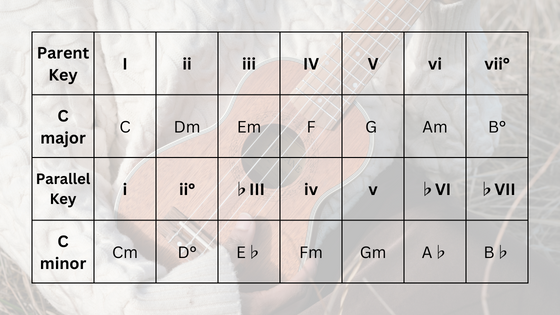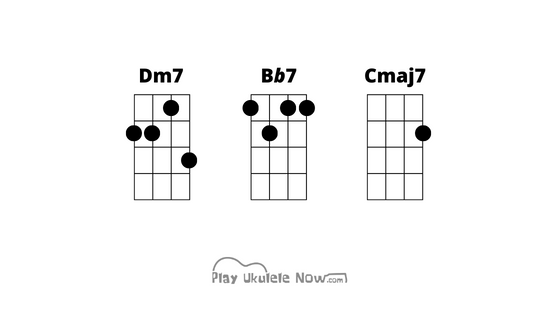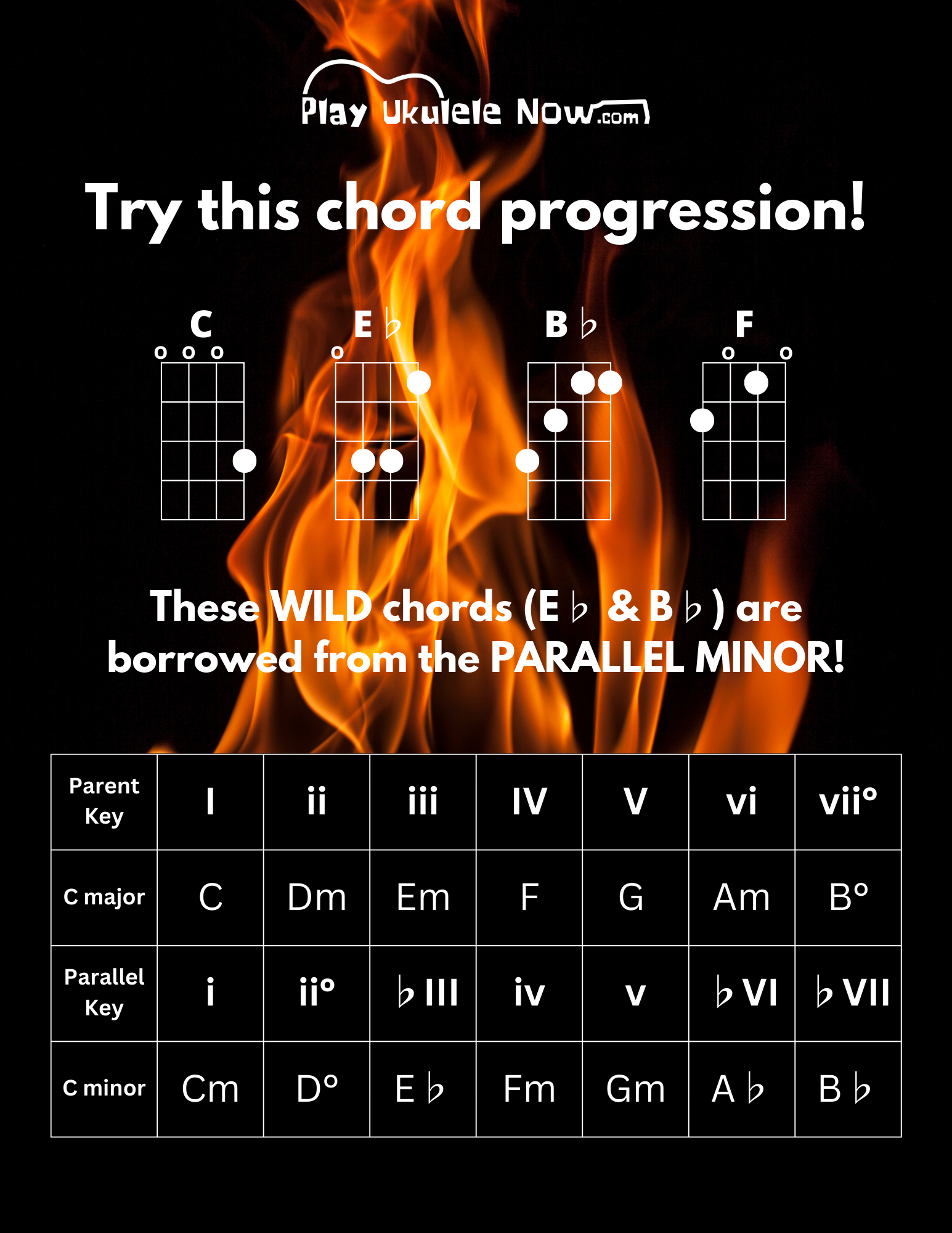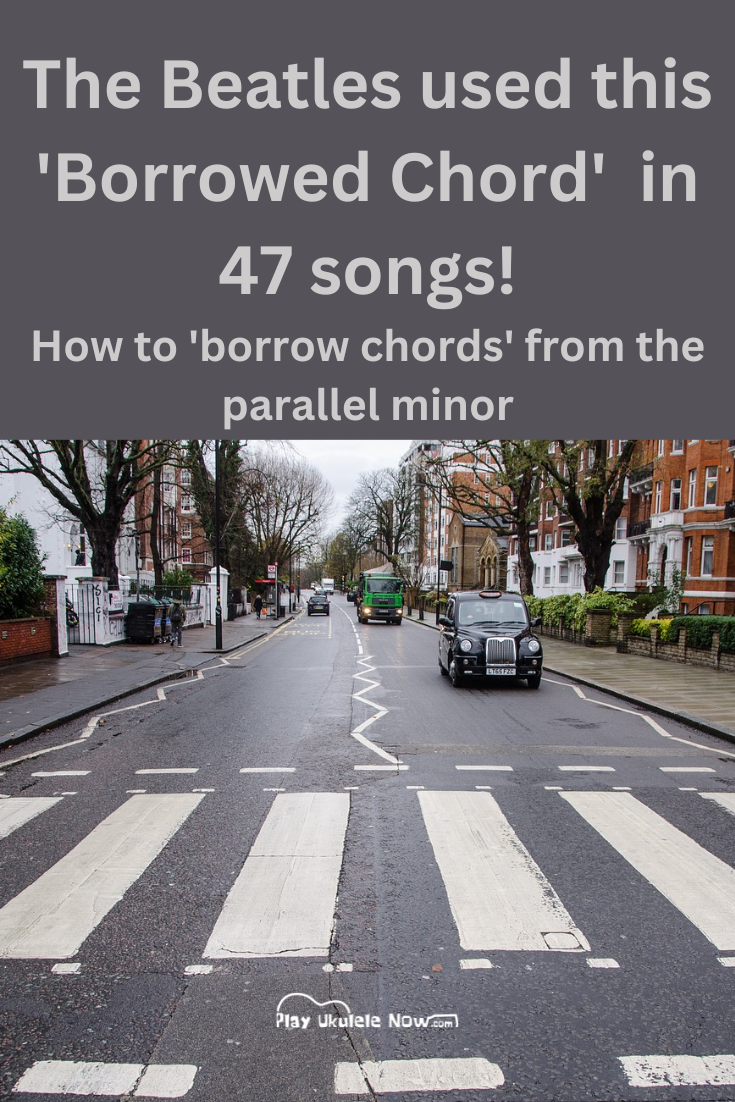Here's how you can use it - and others.
You will Learn More and Play More with Play Ukulele NOW.
Find out for yourself why teachers and students have depended on Play Ukulele NOW Methods and Songbooks since 2009
Find out for yourself why teachers and students have depended on Play Ukulele NOW Methods and Songbooks since 2009
DISCLOSURE: THIS POST MAY CONTAIN AFFILIATE LINKS, MEANING I GET A COMMISSION IF YOU DECIDE TO MAKE A PURCHASE THROUGH MY LINKS, AT NO COST TO YOU. PLEASE READ MY DISCLOSURE FOR MORE INFO.
Find all my chord related posts here: Chord Tips and Tricks
The technique of borrowing chords is used all the time in all styles of music - it's frequently found in modern pop music.
The Beatles had a great producer with a classical background named George Martin, he was sometimes called the 'fifth Beatle' because of his involvement in the music - this is likely the reason we find so many borrowed chords in their songs and why 1 particular borrowed chord made it's appearance in 47 songs!
You'll learn here how to borrow chords from a parallel minor key and how to use them in some chord progressions so you can start writing great songs with them right away!
Borrowing chords from a parallel minor
Let's look at The key of C and it's parallel minor key - C minor
I'm sure you're familiar with the 'parent key' (the key of C) but you may have never used it's parallel minor (C minor).
Rules to remember:
- Every major key has a parallel minor - it's the minor scale that shares the same tonic. The parallel minor of C major is C minor
- You can temporarily borrow chords from other keys to add color to a progression (parallel keys and modes with the same tonic are the most common choices to borrow from).
See my scales harmonized with chords charts so see scales harmonized with chords in all major and minor keys.
Most commonly borrowed chords
Any chords can be borrowed, the most common choices would be:
- bIII (Eb)
- bVI (Ab)
- bVII (Bb)
These chords will have the most dramatic effect - you can borrow a minor for the V, or the IV or the diminished for the ii but these are less common choices, and sometimes go with other rules to use them most effectively for example: we find a minor iv in the Amen cadence and it's preceded by a major IV - like this: F - Fm - C (IV - iv - I).
Can you break the rules? Sure - after you learn them...
we're going to learn the most effective ways to use the most common choices today!
How to use bIII, bVI and bVII in progressions
The borrowed chord the Beatles use most often (in 47 songs) is the bIII, they use lot's of other borrowed chords too (I'll show you some of those as well) but none made their way into the songs as frequently as the bIII.
Sometimes a borrowed chord is thrown in for affect somewhere and sometimes it's part of the progression.
In the song "What a Wonderful World" you have a bVI at "when I think to myself" and it's a great effect. With the Beatles and most pop music it's in the chord progressions.
Here we're going to look at using it in progressions... And with some basic rules I provide on how to use them you'll be able to throw some in as an effect as well.
We'll start with the Beatles favorite...
The bIII
Here are some progressions that use the bIII but will see the bIII later too in some progressions that use other borrowed chords as well.
Here's a real simple one with a heavy focus on the bIII (I- bIII - IV - bIII).
With the Eb the 4th string can be played open.
This one's similar but we continue on with a typical progression after the Eb (I - bIII - IV - V).
As you can see here (the two above) we're using it to spice up a basic I - IV - V or a I - IV progression.
You might expect a I - vi - IV - V in a popular song but we through a monkey wrench it and take you on a wild ride with the I - bIII - IV -V.
NOTE (for advanced players): Interestingly enough Eb is the tritone sub for A! We've talked about there being more than one means to the same end before.
The bVI
Here are a few progressions with the bVI.
This one's nice because of the chromatic movement (I - vi - bVI - V).
Here we use both the 'borrowed chords' we've learned... Notice you're at the 3rd fret for the Ab; the exact same form could be used for the G as well - you could just move the Ab down 1/2 step for the G chord (I - bIII - bVI - V):
Yet another interesting observation (for advanced players): Eb is the tritone of Am, and Ab is the tritone of Dm. This may help you to understand why these chords sound so good.
The bVII
We'll look at a few basic options for this one and get into a jazz progression with the bVII as well - the bVII is used in some very common jazz progressions, called backdoor progressions and the bVII may also be called the backdoor chord - because the bVII considered the (backdoor) alternative to the V.
This is a simple I - bVII - often referred to as the Subtonic Shuttle (because we 'shuttle back and forth between the tonic and the subtonic):
This one is often called a Double Plagal progression because it consists of two plagal cadences (a plagal cadence is a IV - I). bVII - IV and IV - I (bVII - IV - I):
Here we use the Bb to spice up a I - IV - V.
First one is a I - IV - bVII - V:
Next a slight variation of the popular I - V - VI - V (one of the most popular pop and country progressions) We swap out the VI for a bVII to add some color:
Note for advanced players (beginners covers your ears): We swap out the VI for a bVII, we are substituting the submediant (the VI - typically and Am in C) for the subtonic in the parallel minor scale (the bVII - a Bb in C). Original progression: C - G - Am (submediant) - F; new: C - G - bVII (subtonic in parallel minor scale) - F.
Wild isn't it?
Now lets bring back the bIII with a I - bIII - bVII - IV:
Here are some general rules to help you use the chords (these are just guidelines to get you started using them in progressions).(chord) - (should be followed by):
- bIII - IV; bVI; bVII; V
- bVI - V; I; bVII
- bVII - I; IV; bVI; bIII
By following these basic rules of use you should be able to slip these in progressions easily - these are by no means all of the possibilities.
Some examples:
bVII - IV:
- C - Am - Bb - F
- C - G - Bb - F
- C - F - Bb - F
- C - Bb - F - G
- C - Bb - F - C
bVII - bVI:
- C - Bb - Ab - G
- C - Bb - Ab - Bb
- C - G - Bb - Ab - (G)
bVII - bIII:
- C - Bb - Eb - G
Jazzing it up
The bVII is the 'Back Door' to the I chord; rather than playing a Dm7 - G7 - Cmaj7, we use the 'Back Door' to get to the I chord: Dm7 - Bb7 - Cmaj7.
IMPORTANT NOTE: Occasionally any progression using the 'backdoor chord' might be called a 'backdoor progression.'
The 'true' backdoor progression in jazz is Fm7 - Bb7 - Cmaj7, we sub the iv7 and the bVII7 for the ii7 and the V7; the iv7 is the ii7 of the bVII - try it... that chord is in my free chord book - it's (Fm7) 1313. The Fm7 is 'borrowed' from the 'parallel minor' as well!
Here we just look at using the Bb7 (bVII).
Take a look...
The bVII can always be a substitute for the V - resolves beautifully to the I chord.Now spice it up with some subs for the I and the ii. The major 9 #11 will sound beautiful here as a sub for the I so will a major 9 or a 6/9.
We'll soon look at some other subs (embellishments) for the ii (that you can use the the Dm7 here) as well so stay tuned - you've already learned the minor 7b5, you'll soon learn the best forms for the minor 9 and the minor 11. Those three are the most popular choices for a minor 7 sub (embellishment).

.png)

.png)


.png)
.png)
.png)
.png)








.png)



No comments:
Post a Comment